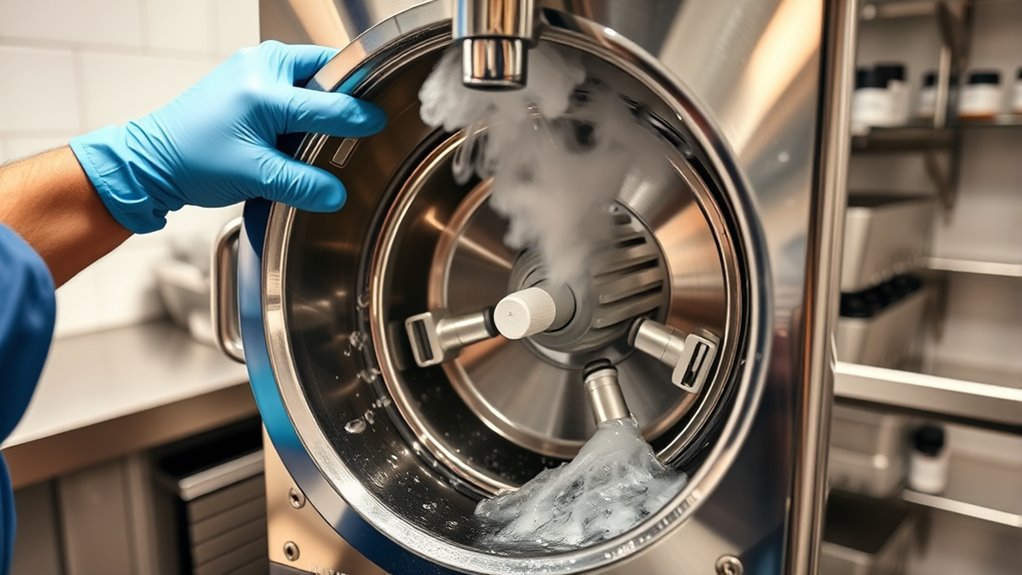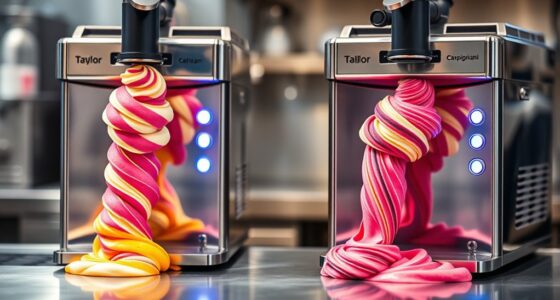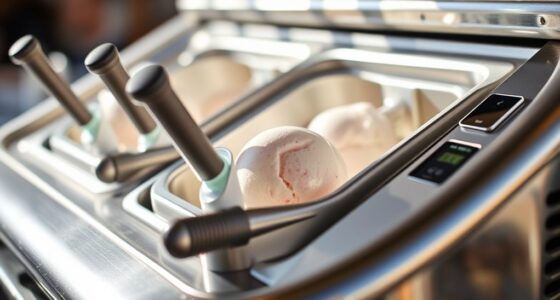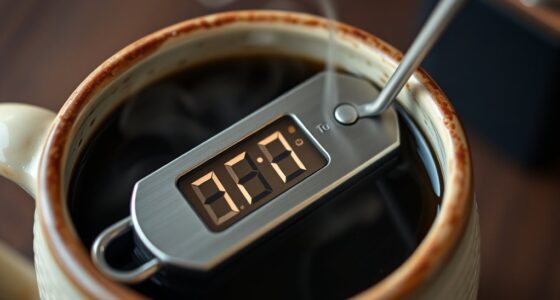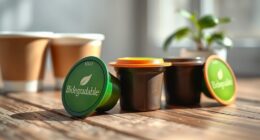To clean your commercial ice cream machine properly, start with a daily routine that removes residual ice cream from key parts like the hopper, dasher, and valves. Sanitize all contact surfaces using food-safe sanitizers, following manufacturer instructions. Always unplug the machine before cleaning, wash removable parts with warm water and mild detergent, then rinse and dry completely. Regular inspections and maintenance ensure peak performance and safety—continue with detailed steps to keep your equipment in top shape.
Key Takeaways
- Unplug the machine, remove all removable parts, and wash them with warm water and mild detergent.
- Sanitize all contact surfaces using food-safe sanitizers following manufacturer instructions.
- Rinse thoroughly to eliminate soap residues and dry all parts completely before reassembling.
- Check for worn seals, gaskets, and leaks; replace or repair as needed for optimal performance.
- Regularly inspect refrigeration temperatures and follow scheduled maintenance to ensure safety and quality.
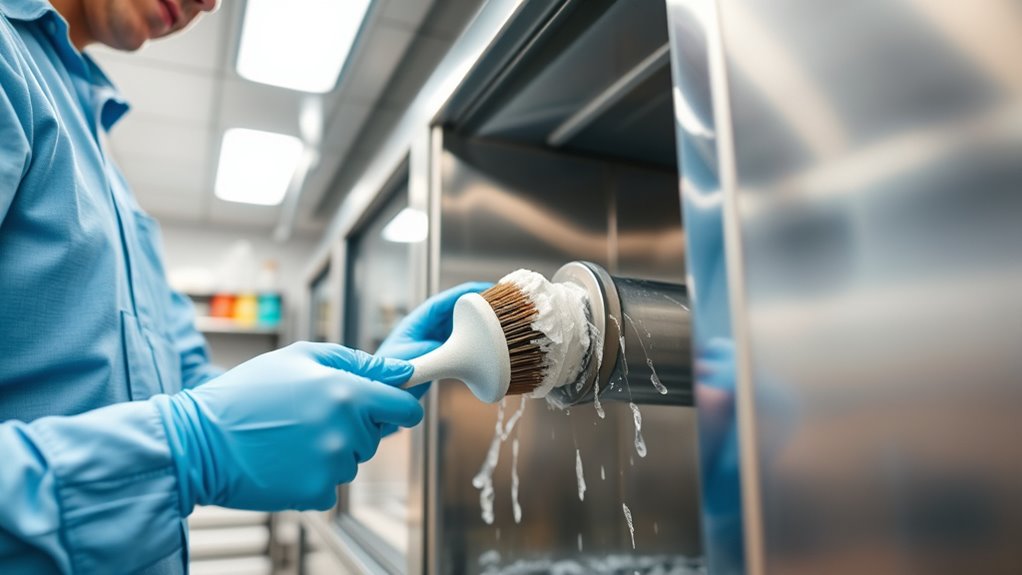
Keeping your commercial ice cream machine clean is vital for ensuring quality, safety, and ideal performance. Regular maintenance routines aren’t just a good idea—they’re necessary to keep your machine running smoothly and to prevent costly repairs down the line. Start by establishing a daily cleaning schedule that includes all the key components: the hopper, dasher, freezing cylinder, and dispensing valves. These routines help remove residual ice cream, prevent bacteria buildup, and maintain consistent product quality. Ignoring maintenance routines can lead to product contamination, poor texture, or even equipment failure, so it’s essential to stay disciplined with your cleaning schedule.
Regular cleaning of your ice cream machine prevents contamination and maintains quality and performance.
Sanitization procedures are equally important and must be integrated into your routine. After each cleaning, sanitize all parts that come into contact with the ice cream—this includes the hopper, mixing blades, and dispensing nozzles. Use food-safe sanitizers approved for dairy equipment, and follow the manufacturer’s instructions carefully to guarantee proper dilution and contact time. Proper sanitization kills bacteria and mold that could otherwise grow unnoticed, ensuring the ice cream remains safe for consumption. Remember, neglecting sanitization can compromise product safety and damage your reputation, so don’t cut corners here.
When performing maintenance routines, always unplug the machine before starting. Remove all removable parts and wash them thoroughly with warm water and mild detergent. Use a soft brush or cloth to scrub away any buildup or residue, paying close attention to crevices and hard-to-reach areas. Rinse everything well to confirm no soap remains, as soap residues can alter your ice cream’s taste or interfere with sanitization. Once cleaned, dry all parts completely before reassembling to prevent mold growth. Regularly inspecting the machine for worn or damaged parts, like seals or gaskets, allows you to replace them before they cause leaks or contamination issues. Additionally, understanding indoor air quality can help in maintaining a healthier environment around your workspace, especially if your cleaning involves strong chemicals.
Incorporate a routine check of the refrigeration system to verify it maintains the proper temperature. If the temperature fluctuates or rises above the recommended range, it could affect freezing consistency or foster bacterial growth. Keep an eye on the machine’s user manual for specific maintenance tasks, such as lubrication or filter replacements, and carry them out as instructed. Staying consistent with these routines not only extends your equipment’s lifespan but also guarantees that every batch of ice cream is safe, delicious, and visually appealing.
Frequently Asked Questions
How Often Should I Clean My Ice Cream Machine for Optimal Performance?
You should follow a proper maintenance schedule to keep your ice cream machine running smoothly. Cleaning frequency depends on usage, but generally, you should clean it daily if used heavily and at least weekly for lighter use. Regular cleaning prevents bacteria buildup and guarantees quality. By sticking to a consistent maintenance schedule, you’ll maximize performance, extend your machine’s lifespan, and maintain the best-tasting ice cream for your customers.
Can I Use Household Cleaning Products to Sanitize the Machine?
You shouldn’t use household cleaners to sanitize your ice cream machine. These products aren’t designed for food equipment and can leave harmful residues. Instead, follow proper sanitizing tips and use cleaning solutions recommended by the manufacturer. Doing so guarantees your machine stays safe and hygienic, preventing contamination and maintaining ideal performance. Always read labels and instructions carefully to choose the right sanitizing agents for your equipment.
What Are the Signs That My Ice Cream Machine Needs Professional Servicing?
It’s ironic how we often ignore signs of trouble, like machine malfunction or unusual noises, until it’s too late. If your ice cream machine struggles to churn or makes odd sounds, it’s a clear sign you need professional servicing. These issues can lead to bigger problems, so don’t wait until your machine completely breaks down. Regular checks help catch problems early, ensuring your business stays cool and smooth.
Is It Necessary to Disassemble the Entire Machine During Cleaning?
You might wonder if you need to do machine disassembly every time you clean your ice cream machine. While thorough cleaning is essential, full disassembly isn’t always necessary unless it’s part of your cleaning frequency schedule or if you notice issues. Regular cleaning should focus on accessible parts, but deep cleaning or maintenance may require disassembly. Follow your manufacturer’s guidelines to keep your machine running smoothly and hygienically.
How Long Does the Cleaning Process Typically Take?
Did you know that improper cleaning can cause up to 50% of machine breakdowns? Typically, the cleaning process takes about 30 to 45 minutes if you follow your cleaning schedule and maintenance checklist. You’ll save time and avoid costly repairs by staying consistent. Rushing can lead to missed spots, so allocate enough time to thoroughly clean your machine, ensuring it runs smoothly and stays hygienic for your customers.
Conclusion
Regularly cleaning your commercial ice cream machine isn’t just about hygiene—it can boost your machine’s efficiency and lifespan. Did you know that failure to clean properly can lead to bacteria buildup, increasing the risk of contamination by up to 60%? By sticking to a consistent cleaning routine, you not only guarantee your ice cream stays delicious and safe but also save money on repairs and replacements. Keep your machine in top shape, and your customers will keep coming back!
